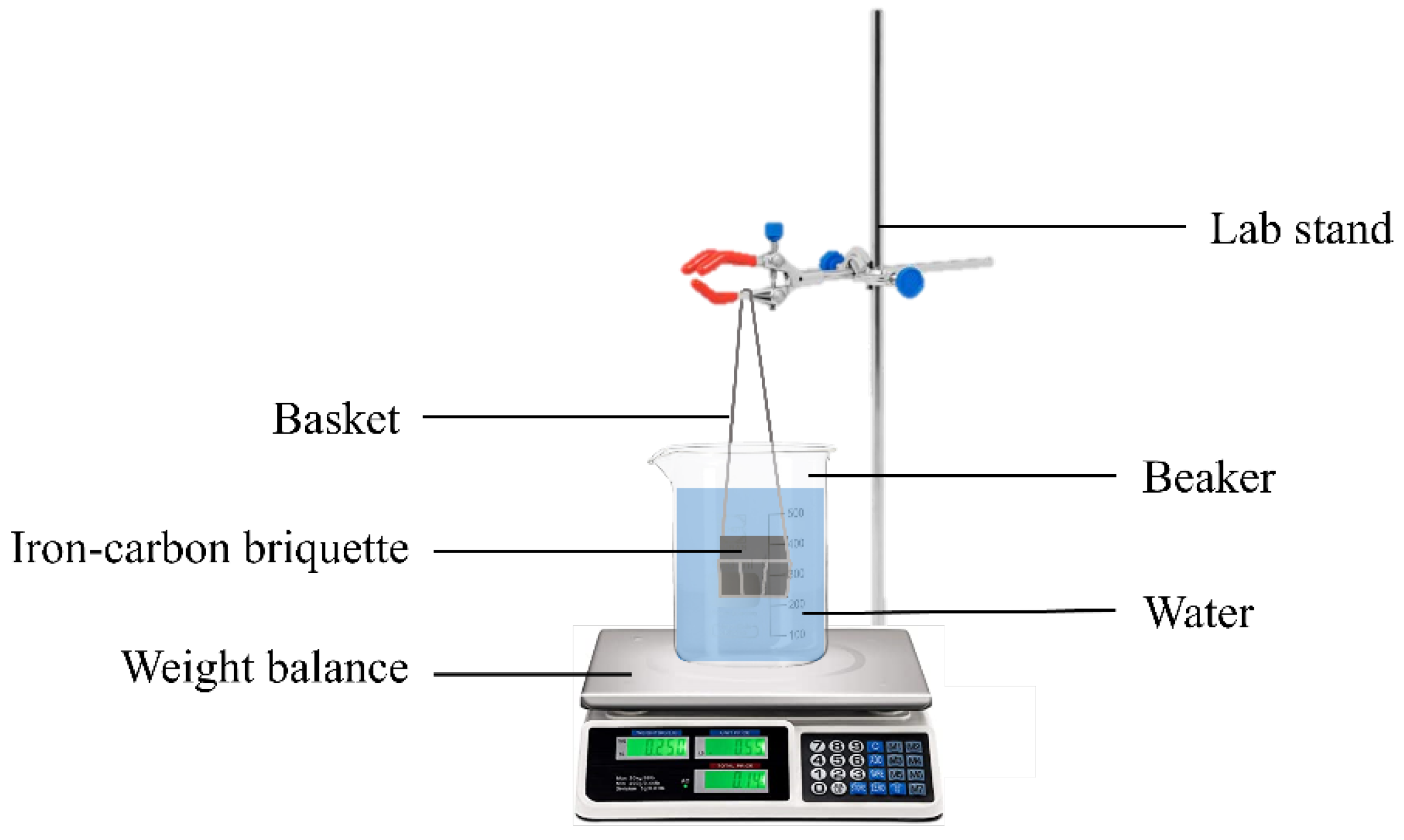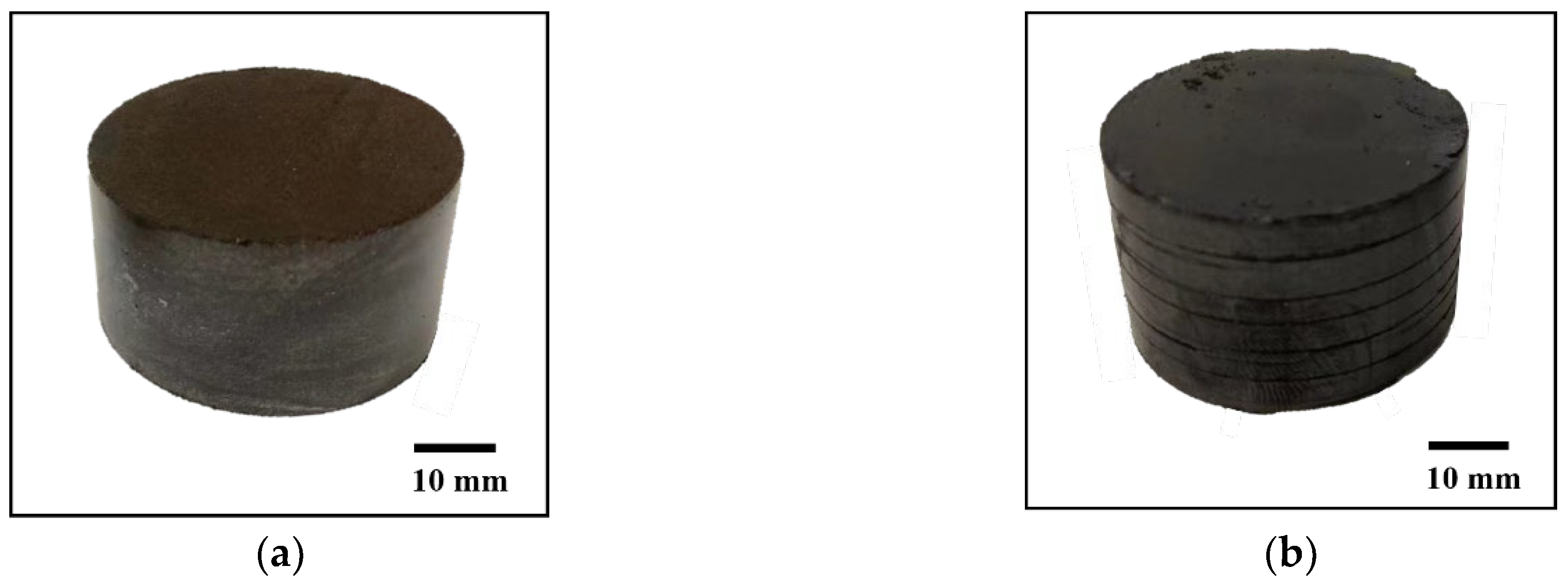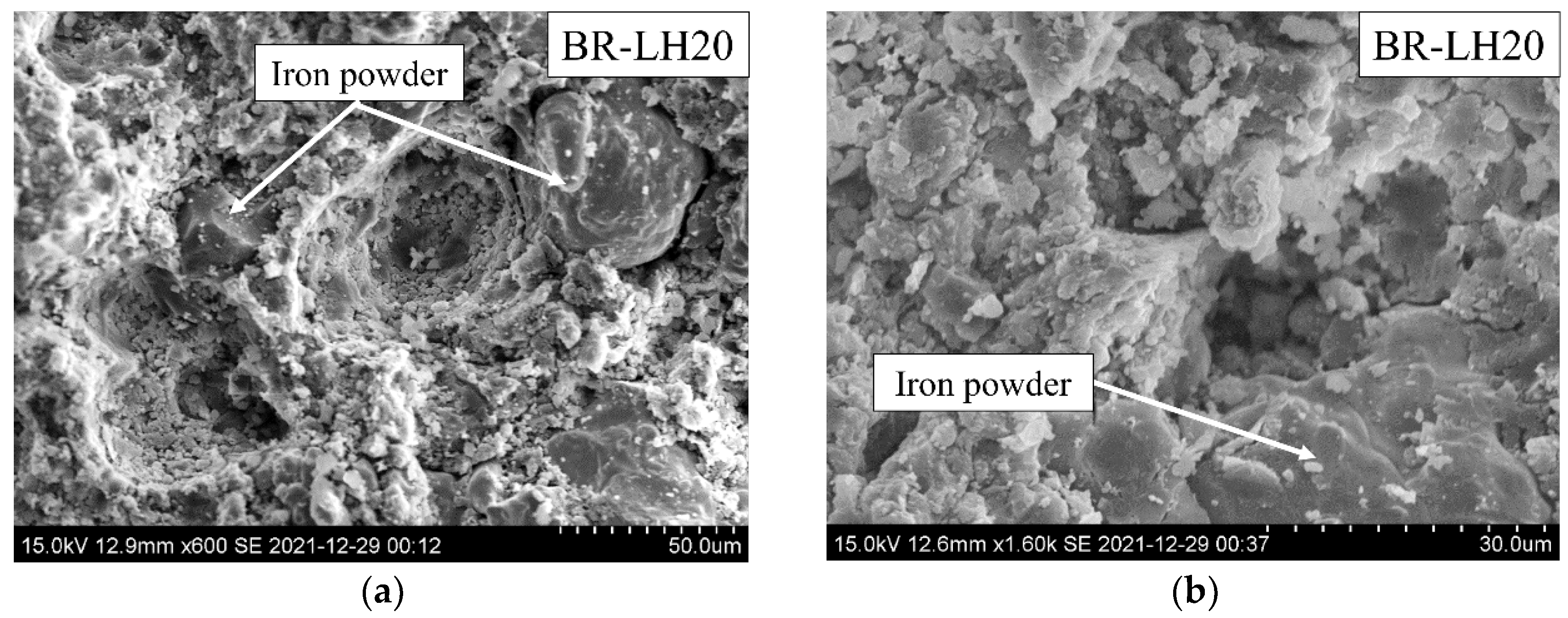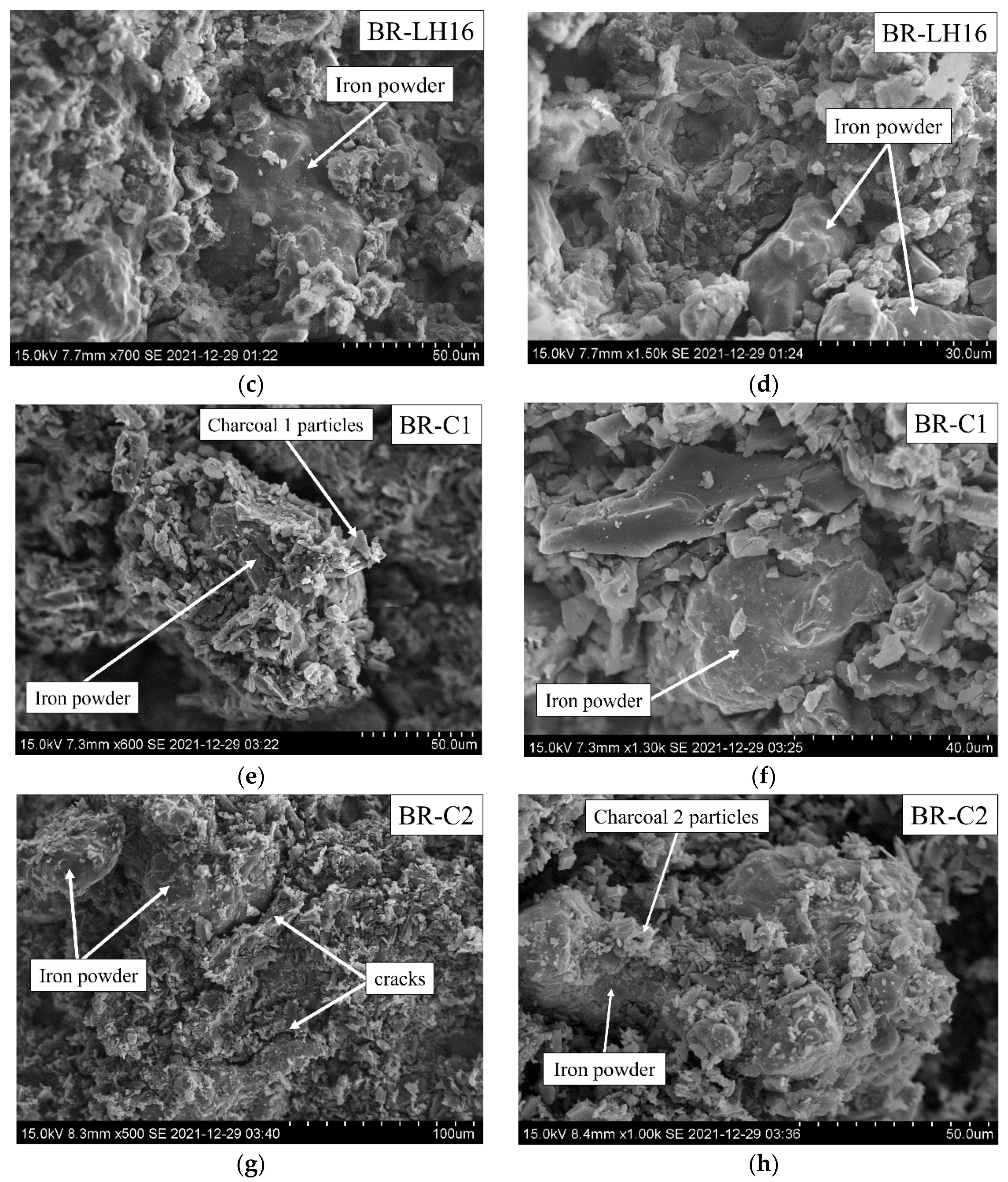Applications of Hydrochar and Charcoal in the Iron and Steelmaking Industry—Part 2: Carburization of Liquid Iron by Addition of Iron–Carbon Briquettes
Abstract
1. Introduction
2. Materials and Methods
2.1. Characterization of Carbonaceous Materials
2.1.1. Description of Materials
2.1.2. Characterization of Binder
2.2. Briquetting and Characterization of Iron–Carbon Briquettes
2.3. Melt Carburization with Iron–Carbon Briquettes
3. Results
3.1. Thermogravimetric Analysis of Binder
3.2. Characterization of Briquettes
| Iron Powder | Charcoal 1 | Charcoal 2 | Lemon Hydrochar | Binder | |
|---|---|---|---|---|---|
| Particle size distribution (µm) | |||||
| d10 | 65.74 | 5.34 | 3.58 | 9.25 | 8.97 |
| d50 | 80.84 | 18.66 | 10.04 | 29.88 | 11.39 |
| d90 | 150.89 | 46.26 | 31.09 | 54.42 | 15.52 |
| Density (kg/m3) | 7.874 [57] | 1.07 ± 0.08 | 0.76 ± 0.06 | 1.23 ± 0.02 | 1.085 ± 0.02 [58] |
| BR-LH20 | BR-LH16 | BR-C1 | BR-C2 | |
|---|---|---|---|---|
| Density (kg/m3) | 3.37 | 3.23 | 2.70 | 2.73 |
3.3. Carburization Experiments
4. Conclusions
- The briquette with a mixture of 20% hydrochar and 80% iron powder had excellent mechanical properties with cold compressive stress > 16 MPa and survived seven drops from 1.0 m above ground. By adding a 4% plastic-based binder to the hydrochar briquette, the weight loss during the drop test was further decreased. Hydrochar has great potential to be used as an organic binder.
- Briquettes that consisted of charcoal, iron powder, and 4% binder had very low cold compressive stress and were easily destroyed during drop tests. Therefore, the briquette recipe should be further optimized in the future
- The recarburization efficiencies from the first stage of carburization were in the order of Charcoal 2 briquette (72.4% for BR-C2) > Charcoal 1 briquette (69.8% for BR-C1) > Hydrochar briquette without binder (57.7% for BR-LH20) > Hydrochar briquette with binder (43.3% for BR-LH16). Only carbon contained in the solid up to a high temperature (1200 °C) could be eventually dissolved in the melt.
- The recarburization efficiencies from the second stage (addition of briquettes in the melt at 1600 °C) were in the following order: Hydrochar briquette without binder (53.5% for BR-LH20) > Hydrochar briquette with binder (48.3% for BR-LH16) > Charcoal 1 briquette (38.7% for BR-C1) > Charcoal 2 briquette (26.4% for BR-C2). Low efficiency of charcoal briquettes was associated with briquette losses from rapid briquette destruction upon contact with the hot melt.
- The volatile matter in hydrochar was not utilized effectively during both stages of carburization. A preliminary slow pyrolysis of hydrochar can be performed to remove volatile matter and use it for other purpose.
Author Contributions
Funding
Acknowledgments
Conflicts of Interest
References
- Suopajärvi, H.; Kemppainen, A.; Haapakangas, J.; Fabritius, T. Extensive review of the opportunities to use biomass-based fuels in iron and steelmaking processes. J. Clean. Prod. 2017, 148, 709–734. [Google Scholar] [CrossRef]
- Mousa, E.; Wang, C.; Riesbeck, J.; Larsson, M. Biomass applications in iron and steel industry: An overview of challenges and opportunities. Renew. Sustain. Energy Rev. 2016, 65, 1247–1266. [Google Scholar] [CrossRef]
- The World Bank Group. Carbon Pricing Dashboard. Available online: https://carbonpricingdashboard.worldbank.org/map_data (accessed on 28 February 2022).
- Wiklund, C.-M.; Helle, M.; Saxén, H. Economic assessment of options for biomass pretreatment and use in the blast furnace. Biomass Bioenergy 2016, 91, 259–270. [Google Scholar] [CrossRef]
- Wei, R.; Zhang, L.; Cang, D.; Li, J.; Li, X.; Xu, C.C. Current status and potential of biomass utilization in ferrous metallurgical industry. Renew. Sustain. Energy 2017, 68, 511–524. [Google Scholar] [CrossRef]
- Suopajärvi, H.; Pongrácz, E.; Fabritius, T. The potential of using biomass-based reducing agents in the blast furnace: A review of thermochemical conversion technologies and assessments related to sustainability. Renew. Sustain. Energy Rev. 2013, 25, 511–528. [Google Scholar] [CrossRef]
- Echterhof, T. Review on the Use of Alternative Carbon Sources in EAF Steelmaking. Metals 2021, 11, 222. [Google Scholar] [CrossRef]
- Fraga, M.; Flores, B.; Osório, E.; Vilela, A. Evaluation of the thermoplastic behavior of charcoal, coal tar and coking coal blends. J. Mater. Res. Technol. 2020, 9, 3406–3410. [Google Scholar] [CrossRef]
- Aziz, H.; Rodrigues, S.; Esterle, J.S.; Steel, K.M. Interactions between vitrinite and solid additives including inertinite during pyrolysis for coke-making considerations. Fuel Processing Technol. 2020, 201, 106321. [Google Scholar] [CrossRef]
- Guerrero, A.; Diez, M.A.; Borrego, A.G. Influence of charcoal fines on the thermoplastic properties of coking coals and the optical properties of the semicoke. Int. J. Coal Geol. 2015, 147–148, 105–114. [Google Scholar] [CrossRef]
- Riva, L.; Nielsen, H.K.; Skreiberg, Ø.; Wang, L.; Bartocci, P.; Barbanera, M.; Bidini, G.; Fantozzi, F. Analysis of optimal temperature, pressure and binder quantity for the production of biocarbon pellet to be used as a substitute for coke. Appl. Energy 2019, 256, 113933. [Google Scholar] [CrossRef]
- Kamal Baharin, N.S.; Koesoemadinata, V.C.; Nakamura, S.; Yahya, W.J.; Muhammad Yuzir, M.A.; Md Akhir, F.N.; Iwamoto, K.; Othman, N.A.; Ida, T.; Hara, H. Conversion and characterization of Bio-Coke from abundant biomass waste in Malaysia. Renew. Energy 2020, 162, 1017–1025. [Google Scholar] [CrossRef]
- Wang, C.; Mellin, P.; Lövgren, J.; Nilsson, L.; Yang, W.; Salman, H.; Hultgren, A.; Larsson, M. Biomass as blast furnace injectant—Considering availability, pretreatment and deployment in the Swedish steel industry. Energy Convers. Manag. 2015, 102, 217–226. [Google Scholar] [CrossRef]
- Solar, J.; Hippe, F.; Babich, A.; Caballero, B.M.; de Marco Rodríguez, I.; Barriocanal, C.; López-Urionabarrenechea, A.; Acha, E. Conversion of Injected Forestry Waste Biomass Charcoal in a Blast Furnace: Influence of Pyrolysis Temperature. Energy Fuels 2021, 35, 529–538. [Google Scholar] [CrossRef]
- Lovel, R.; Vining, K.; Dell’Amico, M. Iron ore sintering with charcoal. Miner. Process. Extr. Metall. 2007, 116, 85–92. [Google Scholar] [CrossRef]
- Cheng, Z.; Yang, J.; Zhou, L.; Liu, Y.; Wang, Q. Characteristics of charcoal combustion and its effects on iron-ore sintering performance. Appl. Energy 2016, 161, 364–374. [Google Scholar] [CrossRef]
- Ooi, T.C.; Thompson, D.; Anderson, D.R.; Fisher, R.; Fray, T.; Zandi, M. The effect of charcoal combustion on iron-ore sintering performance and emission of persistent organic pollutants. Combust. Flame 2011, 158, 979–987. [Google Scholar] [CrossRef]
- Mousa, E.; Kazemi, M.; Larsson, M.; Karlsson, G.; Persson, E. Potential for Developing Biocarbon Briquettes for Foundry Industry. Appl. Sci. 2019, 9, 5288. [Google Scholar] [CrossRef]
- Jarnerud, T.; Karasev, A.; Wang, C.; Bäck, F.; Jönsson, P. Utilization of Organic Mixed Biosludge from Pulp and Paper Industries and Green Waste as Carbon Sources in Blast Furnace Hot Metal Production. Sustainability 2021, 13, 7706. [Google Scholar] [CrossRef]
- Kowitwarangkul, P.; Babich, A.; Senk, D. Reduction Behavior of Self-Reducing Pellet (SRP) for Low Height Blast Furnace. Steel Res. Int. 2014, 85, 1501–1509. [Google Scholar] [CrossRef]
- Konishi, H.; Ichikawa, K.; Usui, T. Effect of Residual Volatile Matter on Reduction of Iron Oxide in Semi-charcoal Composite Pellets. ISIJ Int. 2010, 50, 386–389. [Google Scholar] [CrossRef]
- Skoczkowski, T.; Verdolini, E.; Bielecki, S.; Kochański, M.; Korczak, K.; Węglarz, A. Technology innovation system analysis of decarbonisation options in the EU steel industry. Energy 2020, 212, 118688. [Google Scholar] [CrossRef] [PubMed]
- Luh, S.; Budinis, S.; Schmidt, T.J.; Hawkes, A. Decarbonisation of the Industrial Sector by means of Fuel Switching, Electrification and CCS. In Computer Aided Chemical Engineering; Friedl, A., Klemeš, J.J., Radl, S., Varbanov, P.S., Wallek, T., Eds.; Elsevier: Amsterdam, The Netherlands, 2018; Volume 43, pp. 1311–1316. [Google Scholar]
- Baracchini, G.; Bianco, L.; Cirilli, F.; Echterhof, T.; Griessacher, T.; Marcos, M.; Mirabile, D.; Reichel, T.; Rekersdrees, T.; Sommerauer, H. Biochar for a Sustainable EAF Steel Production (GREENEAF2); Publications Office of the European Union: Luxembourg, 2018. [Google Scholar]
- Bianco, L.; Baracchini, G.; Cirilli, F.; Sante, L.D.; Moriconi, A.; Moriconi, E.; Agorio, M.M.; Pfeifer, H.; Echterhof, T.; Demus, T.; et al. Sustainable Electric Arc Furnace Steel Production: GREENEAF. BHM Berg Hüttenmännische Mon. 2013, 158, 17–23. [Google Scholar] [CrossRef]
- Cirilli, F.; Baracchini, G.; Bianco, L. EAF long term industrial trials of utilization of char from biomass as fossil coal substitute. Metall. Ital. 2017, 109, 13–17. [Google Scholar]
- Huang, X.-A.; Ng, K.W.; Giroux, L.; Duchesne, M. Carbonaceous Material Properties and Their Interactions with Slag During Electric Arc Furnace Steelmaking. Metall. Mater. Trans. B 2019, 50, 1387–1398. [Google Scholar] [CrossRef]
- Yunos, N.F.M.; Zaharia, M.; Idris, M.A.; Nath, D.; Khanna, R.; Sahajwalla, V. Recycling Agricultural Waste from Palm Shells during Electric Arc Furnace Steelmaking. Energy Fuels 2012, 26, 278–286. [Google Scholar] [CrossRef]
- Fidalgo, B.; Berrueco, C.; Millan, M. Chars from agricultural wastes as greener fuels for electric arc furnaces. J. Anal. Appl. Pyrolysis 2015, 113, 274–280. [Google Scholar] [CrossRef]
- Yunos, N.F.M.; Ahmad, K.R.; Zaharia, M.; Sahajwalla, V. Combustion of Agricultural Waste and Coke Blends during High Temperature Processes: Effect of Physical, Chemical and Surface Properties. J. Jpn. Soc. Exp. Mech. 2011, 11, s261–s266. [Google Scholar] [CrossRef]
- Mathieson, J.; Rogers, H.; Somerville, M.; Ridgeway, P.; Jahanshahi, S. Use of Biomass in the Iron and Steel Industry—An Australian Perspective. In Proceedings of the 1st International Conference on Energy Efficiency and CO2 Reduction in the Steel Industry (EECR Steel 2011)—Incorporated in METEC InSteelCon 2011, Dusseldorf, Germany, 27 June–1 July 2011; The Steel Institute VDEh: Dusseldorf, Germany, 2011. Available online: http://hdl.handle.net/102.100.100/103943?index=1 (accessed on 28 February 2022).
- Rađenović, A.; Kolar, M. Petroleum coke as carburizing material in foundry. Nafta 2004, 55, 409–412. [Google Scholar]
- Somerville, M.; Jahanshahi, S.; Ridgeway, P.; Davies, M.; Mathieson, J. Sustainable carbon in steelmaking—Plant trials at the Sydney Steel Mill, Sustainable. In Proceedings of the Sustainable Mining 2010—The Business Case, Kalgoorlie, WA, Australia, 17–19 August 2010; AusIMM: Melbourne, Australia, 2010; pp. 38–52. [Google Scholar]
- Robinson, R.; Brabie, L.; Pettersson, M.; Amovic, M.; Ljunggren, R. An Empirical Comparative Study of Renewable Biochar and Fossil Carbon as Carburizer in Steelmaking. ISIJ Int. 2020, advpub. [Google Scholar] [CrossRef]
- Janerka, K.; Jezierski, J.; Jan, S. Quality and properties of the cast iron produced on the steel scrap base. Arch. Mater. Sci. Eng. 2012, 53, 92–101. [Google Scholar]
- Riva, L.; Surup, G.R.; Buø, T.V.; Nielsen, H.K. A study of densified biochar as carbon source in the silicon and ferrosilicon production. Energy 2019, 181, 985–996. [Google Scholar] [CrossRef]
- Mathieson, J.G.; Somerville, M.A.; Deev, A.; Jahanshahi, S. 19—Utilization of biomass as an alternative fuel in ironmaking. In Iron Ore; Lu, L., Ed.; Woodhead Publishing: Sawston, UK, 2015; pp. 581–613. [Google Scholar]
- Somerville, M.A.; Mathieson, J.G.; Ridgeway., P.L. Overcoming problems of using charcoal as a substitute for coke in iron and steelmaking operations. In Proceedings of the 42º Seminário de Redução de Minério de Ferro e Matérias-primas/13º Seminário Brasileiro de Minério de Ferro/6th International Congress on the Science and Technology of Ironmaking, Rio de Janeiro, Brazil, 14–18 October 2012. [Google Scholar]
- Hu, Q.; Shao, J.; Yang, H.; Yao, D.; Wang, X.; Chen, H. Effects of binders on the properties of bio-char pellets. Appl. Energy 2015, 157, 508–516. [Google Scholar] [CrossRef]
- Hu, Q.; Yang, H.; Yao, D.; Zhu, D.; Wang, X.; Shao, J.; Chen, H. The densification of bio-char: Effect of pyrolysis temperature on the qualities of pellets. Bioresour. Technol. 2016, 200, 521–527. [Google Scholar] [CrossRef] [PubMed]
- Demus, T.; Echterhof, T.; Pfeifer, H.; Schulten, M.; Quicker, P. Investigations on the Use of Biogenic Residues as a Substitute for Fossil Coal in the Eaf Steelmaking Process. In Proceedings of the 10th European Electric Steelmaking Conference: EEC 2012, Graz, Austria, 25–28 September 2012; The Austrian Society For Metallurgy And Materials (Asmet): Leoben, Austria, 2012; pp. 500–509. [Google Scholar]
- Zhou, Y.; Lin, M.; Zhong, M.; Yan, X.; Yang, Y. Molten metal and water direct contact interaction research—I. Photographic experiment study. Ann. Nucl. Energy 2014, 70, 248–255. [Google Scholar] [CrossRef]
- Kudo, S.; Mori, A.; Soejima, R.; Murayama, F.; Karnowo; Nomura, S.; Dohi, Y.; Norinaga, K.; Hayashi, J.-i. Preparation of Coke from Hydrothermally Treated Biomass in Sequence of Hot Briquetting and Carbonization. ISIJ Int. 2014, 54, 2461–2469. [Google Scholar] [CrossRef][Green Version]
- Sharma, H.B.; Panigrahi, S.; Dubey, B.K. Hydrothermal carbonization of yard waste for solid bio-fuel production: Study on combustion kinetic, energy properties, grindability and flowability of hydrochar. Waste Manag. 2019, 91, 108–119. [Google Scholar] [CrossRef]
- Sharma, H.B.; Dubey, B.K. Binderless fuel pellets from hydrothermal carbonization of municipal yard waste: Effect of severity factor on the hydrochar pellets properties. J. Clean. Prod. 2020, 277, 124295. [Google Scholar] [CrossRef]
- Liu, Z.; Quek, A.; Balasubramanian, R. Preparation and characterization of fuel pellets from woody biomass, agro-residues and their corresponding hydrochars. Appl. Energy 2014, 113, 1315–1322. [Google Scholar] [CrossRef]
- Hoekman, S.K.; Broch, A.; Warren, A.; Felix, L.; Irvin, J. Laboratory pelletization of hydrochar from woody biomass. Biofuels 2014, 5, 651–666. [Google Scholar] [CrossRef]
- Reza, M.T.; Uddin, M.H.; Lynam, J.G.; Coronella, C.J. Engineered pellets from dry torrefied and HTC biochar blends. Biomass Bioenergy 2014, 63, 229–238. [Google Scholar] [CrossRef]
- Wu, S.; Zhang, S.; Wang, C.; Mu, C.; Huang, X. High-strength charcoal briquette preparation from hydrothermal pretreated biomass wastes. Fuel Process. Technol. 2018, 171, 293–300. [Google Scholar] [CrossRef]
- Cao, Z.; Zhang, S.; Huang, X.; Liu, H.; Sun, M.; Lyu, J. Correlations between the compressive strength of the hydrochar pellets and the chemical components: Evolution and densification mechanism. J. Anal. Appl. Pyrolysis 2020, 152, 104956. [Google Scholar] [CrossRef]
- Lu, Y.-C.; Yang, H.M.; Karasev, A.V.; Wang, C. Applications of hydrochar and charcoal in the iron and steelmaking industry- Part 1: Characterization of carbonaceous materials. Sustainability, 2022; Unpublished. [Google Scholar]
- Jarnerud, T.; Karasev, A.; Jönsson, P. Briquetting of Wastes from Pulp and Paper Industries by Using AOD Converter Slag as Binders for Application in Metallurgy. Materials 2019, 12, 2888. [Google Scholar] [CrossRef] [PubMed]
- Kovačič, M.; Stopar, K.; Vertnik, R.; Šarler, B. Comprehensive Electric Arc Furnace Electric Energy Consumption Modeling: A Pilot Study. Energies 2019, 12, 2142. [Google Scholar] [CrossRef]
- Jung, E.; Kim, H.; Yang, H.; Andersson, J.; Kim, K.; Teng, L.; Lee, E. Problems with and Solutions to Skull Formation in EBT Furnace for Tool and Stainless Steel Production. In Proceedings of the Iron & Steel Technology Conference (AISTech 2020), Cleveland, OH, USA, 31 August–3 September 2020; pp. 583–593. [Google Scholar]
- Mostafaee, S. A Study of EAF High-Chromium Stainless Steelmaking Slags Characteristics and Foamability. Ph.D. Thesis, KTH Royal Institute of Technology, Stockholm, Sweden, 2011. comprehensive summary. [Google Scholar]
- Bazargan, A.; Rough, S.L.; McKay, G. Compaction of palm kernel shell biochars for application as solid fuel. Biomass Bioenergy 2014, 70, 489–497. [Google Scholar] [CrossRef]
- Andersson, J.O.; Helander, T.; Höglund, L.; Shi, P.; Sundman, B. Thermo-Calc & DICTRA, computational tools for materials science. Calphad 2002, 26, 273–312. [Google Scholar] [CrossRef]
- Arkema Inc. Safety Data Sheet—Orgasol® 3502 D NAT 1. 2017. Available online: https://www.palmerholland.com/getmedia/4b9cfaff-b4a3-46a5-932c-17d1cdff56fe/MITM01773_1 (accessed on 28 February 2022).
- Fernández-Sanromán, Á.; Lama, G.; Pazos, M.; Rosales, E.; Sanromán, M.Á. Bridging the gap to hydrochar production and its application into frameworks of bioenergy, environmental and biocatalysis areas. Bioresour. Technol. 2021, 320, 124399. [Google Scholar] [CrossRef]
- Pathak, P.D.; Mandavgane, S.A.; Kulkarni, B.D. Fruit peel waste: Characterization and its potential uses. Curr. Sci. 2017, 113, 444–454. [Google Scholar] [CrossRef]
- Panwar, N.L.; Kothari, R.; Tyagi, V.V. Thermo chemical conversion of biomass—Eco friendly energy routes. Renew. Sustain. Energy Rev. 2012, 16, 1801–1816. [Google Scholar] [CrossRef]
- Edenhofer, B.; Joritz, D.; Rink, M.; Voges, K. 13—Carburizing of steels. In Thermochemical Surface Engineering of Steels; Mittemeijer, E.J., Somers, M.A.J., Eds.; Woodhead Publishing: Oxford, UK, 2015; pp. 485–553. [Google Scholar]
- Mourao, M.B.; Murthy, G.G.K.; Elliott, J.F. Experimental investigation of dissolution rates of carbonaceous materials in liquid iron-carbon melts. Metall. Trans. B 1993, 24, 629–637. [Google Scholar] [CrossRef]










| Material | Charcoal 1 | Charcoal 2 | Lemon Hydrochar | Binder |
|---|---|---|---|---|
| Proximate analysis (db 1) | ||||
| Volatile matter | 19.7 | 11.4 | 67.0 | NA 2 |
| Ultimate analysis (db 1) | ||||
| C | 86.6 | 89.0 | 59.8 | 67.1 |
| H | 1.8 | 0.5 | 5.7 | 11.0 |
| N | 0.57 | 0.61 | 1.45 | 11.61 |
| O | 6.5 | 4.2 | 26.8 | 10.3 |
| S | 0.029 | 0.070 | 0.074 | 0.037 |
| Others (by difference) | 4.500 | 5.620 | 6.176 | 0.003 |
| C | S | P | Si | Mn | Cr | Ni | Cu | Mo | Sn | Ca | |
|---|---|---|---|---|---|---|---|---|---|---|---|
| Iron powder | 0.010 | 0.008 | 0.0026 | 0.001 | 0.064 | 0.026 | 0.014 | 0.012 | 0.001 | 0.002 | 0.003 |
| Electrolytic iron | 0.007 | 0.004 | 0.0030 | 0.054 | 0.030 | 0.016 | 0.013 | <0.001 | <0.001 | <0.001 | NA |
| Briquette ID | Type of Carbon Material | Percentage of Carbon Materials (%) | Percentage of Iron Powder (%) | Percentage of Binder (%) |
|---|---|---|---|---|
| BR-LH20 | Lemon Hydrochar | 20 | 80 | 0 |
| BR-LH16 | Lemon Hydrochar | 16 | 80 | 4 |
| BR-C1 | Charcoal 1 | 16 | 80 | 4 |
| BR-C2 | Charcoal 2 | 16 | 80 | 4 |
| BR-LH20 | BR-LH16 | BR-C1 | BR-C2 | |
|---|---|---|---|---|
| Total weight of EI (g) | 10,000.00 | |||
| Total weight of briquettes | 393.20 | 398.18 | 377.34 | 299.30 |
| Weight of IP in briquettes (g) | 314.56 | 318.54 | 301.87 | 239.44 |
| Weight of carbon materials in briquettes (g) | 78.64 | 63.71 | 60.37 | 47.89 |
| Weight of binder in briquettes (g) | 0.0 | 15.90 | 15.1 | 12.0 |
| Carbon in EI (g) | 0.7 | |||
| Carbon in IP (g) | 0.03 | 0.03 | 0.03 | 0.02 |
| Total carbon in carbon materials (g) | 47.03 | 38.10 | 52.28 | 42.62 |
| Carbon in residual char (solid) (g) | 25.57 | 20.72 | 46.98 | 38.51 |
| Carbon in volatile matter (gas) (g) | 21.45 | 17.38 | 5.31 | 4.11 |
| Total carbon content in binder (g) | 0.00 | 10.69 | 10.13 | 8.03 |
| Total added carbon excluding EI, IP(g) | 47.03 | 48.79 | 62.41 | 50.65 |
| Dissolved carbon in melt (g) | 27.12 | 21.15 | 43.57 | 36.67 |
| Percentage of added carbon in solid phase (%) | 54.38 | 42.47 | 75.27 | 76.02 |
| Recarburization efficiency (%) | 57.67 | 45.34 | 69.87 | 72.40 |
| BR-LH20 | BR-LH16 | BR-C1 | BR-C2 | |
|---|---|---|---|---|
| Total weight of EI (g) | 0.00 | |||
| Total weight of briquettes | 397.94 | 397.58 | 384.67 | 170.60 |
| Weight of IP in briquettes (g) | 318.35 | 318.06 | 307.74 | 136.48 |
| Weight of carbon materials in briquettes (g) | 79.59 | 63.61 | 61.55 | 27.30 |
| Weight of binder in briquettes (g) | 0.0 | 15.90 | 15.39 | 6.82 |
| Carbon in EI (g) | 0.00 | |||
| Carbon in IP (g) | 0.03 | 0.03 | 0.03 | 0.01 |
| Total carbon in carbon materials (g) | 47.59 | 38.04 | 53.30 | 24.29 |
| Carbon in residual char (g) | 25.88 | 20.69 | 47.89 | 21.95 |
| Carbon in volatile matter (g) | 21.71 | 17.35 | 5.41 | 2.35 |
| Total carbon content in binder (g) | 0.00 | 10.67 | 10.32 | 4.58 |
| Total added carbon excluding EI, IP (g) | 47.59 | 48.71 | 63.62 | 28.87 |
| Dissolved carbon in melt (g) | 25.45 | 23.53 | 24.65 | 7.61 |
| Percentage of added carbon in solid phase (%) | 54.38 | 42.47 | 75.27 | 76.02 |
| Recarburization efficiency (%) | 53.47 | 48.30 | 38.74 | 26.37 |
Publisher’s Note: MDPI stays neutral with regard to jurisdictional claims in published maps and institutional affiliations. |
© 2022 by the authors. Licensee MDPI, Basel, Switzerland. This article is an open access article distributed under the terms and conditions of the Creative Commons Attribution (CC BY) license (https://creativecommons.org/licenses/by/4.0/).
Share and Cite
Lu, Y.-C.; Brabie, L.; Karasev, A.V.; Wang, C. Applications of Hydrochar and Charcoal in the Iron and Steelmaking Industry—Part 2: Carburization of Liquid Iron by Addition of Iron–Carbon Briquettes. Sustainability 2022, 14, 5383. https://doi.org/10.3390/su14095383
Lu Y-C, Brabie L, Karasev AV, Wang C. Applications of Hydrochar and Charcoal in the Iron and Steelmaking Industry—Part 2: Carburization of Liquid Iron by Addition of Iron–Carbon Briquettes. Sustainability. 2022; 14(9):5383. https://doi.org/10.3390/su14095383
Chicago/Turabian StyleLu, Yu-Chiao, Liviu Brabie, Andrey V. Karasev, and Chuan Wang. 2022. "Applications of Hydrochar and Charcoal in the Iron and Steelmaking Industry—Part 2: Carburization of Liquid Iron by Addition of Iron–Carbon Briquettes" Sustainability 14, no. 9: 5383. https://doi.org/10.3390/su14095383
APA StyleLu, Y.-C., Brabie, L., Karasev, A. V., & Wang, C. (2022). Applications of Hydrochar and Charcoal in the Iron and Steelmaking Industry—Part 2: Carburization of Liquid Iron by Addition of Iron–Carbon Briquettes. Sustainability, 14(9), 5383. https://doi.org/10.3390/su14095383







